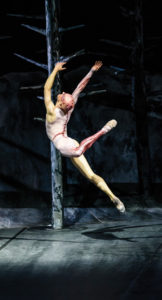London: Fall 2016 - Vancouver Ballet Society
- Home
- City Reports 2015 - 2019
- London: Fall 2016

by Sanjoy Roy
Everyone “knows” the story of Frankenstein: mad scientist, lightning, monster, kill, kill. Of course, James Whale’s classic film is very different from Mary Shelley’s classic novel, but that skeleton of a plot is common to both. The same is true for Liam Scarlett’s new full-length work for the Royal Ballet (co-produced by San Francisco Ballet), which cleaves closely to the original Shelley rather than to Whale. Which is why it feels so odd to find yourself, half an hour in, still uncertain who the characters are, what is happening and why.
The ballet, which premiered at the Royal Opera House in May, begins promisingly enough: ominous swells of sound, a title sequence of grand landscapes and portentous storms projected onto a frontcloth. Just like in the movies. But nearly all of the 50-minute first act feels like a misguided prologue, an attempt to give the drama an explanatory emotional backstory by illustrating the childhood love between Victor Frankenstein (Tristan Dyer, on the night I went) and his later wife, Elizabeth (Sarah Lamb), the pain caused by the death of his mother, the thirst for knowledge encouraged by his father — all set within a polite Victorian household and choreographed with well-mannered steps. But Frankenstein is a gothic tale, not a case history; such drawing-room psychologizing diminishes — domesticates, even — its uncanny force.
In any case, it’s hard to tell who the sketchily drawn characters actually are, and writing on the frontcloth spelling out that Victor is “thinking of his mother and life and death” feels like a vain gesture toward big ideas. The blood quickens only once we get to the anatomy theatre scene, and thence to the heart of the story: Frankenstein and his monster.
Following a mordantly wicked divertissement of nurses cavorting with assorted body parts, Victor takes off into vertical jumps of excitement while his splendid electromechanical contraption of wheels and wires pops and crackles. At first he believes his experiment has failed, unaware that the creature is twitching horribly into life. The monster (Ryoichi Hirano) looms large behind him, ghoulish and ghastly in a costume of flayed skin and suppurating sutures — and then all it does, pretty much, is run out of the room. The “It’s alive!” moment has been squandered.
It’s a real shame that Act 1 is such a dud, because it weighs heavily on the far superior Acts 2 and 3. The choreography now begins to unsettle more than explain. The pas de deux for Elizabeth and Victor is a lyric skein of steps threaded with anxiety: flows and congruencies that unexpectedly double back, pitch off balance and slip out of line. It’s a beautiful embodiment of the disquiet infusing their romance.
The garden party scene — Victor’s young brother William playing blind-man’s bluff until he encounters the creature — elicits both repulsion and sympathy for the monster. We feel the horror of the young boy’s murder, yet sense it as an act born of pain more than evil. The final act’s ballroom scene is haunting, with the creature shadow-waltzing among the guests at Victor and Elizabeth’s wedding party, the spectre at their feast. He stalks, then kills, each of Victor’s remaining loved ones — a trail of death and vengeance that leads inexorably to the monster’s final doomed encounter with his maker.
Throughout, John Macfarlane’s suitably exaggerated set — gloomy landscapes, uptight interiors — works wonders for the mood without crowding the dancers, though Lowell Lieberman’s televisual score is more workaday than inspiring. Scarlett himself has a genuine gift in making steps both lyrical and meaningful, even if he sometimes seems overly constrained by balletic good taste.
Several critics accused him of imitating scenes from ballets by past masters (Ashton, MacMillan), but I have no problem with imitation if it works in context; moreover, here you could plausibly argue that stitching in parts of other ballets is entirely appropriate for this creation. No, the real problem is that Frankenstein never comes to life as an entity. You recognize the sparks of quickening within it (the ballroom scene, the turbulent duets, the crafted steps), yet every scene that hits the spot then goes on to outstay its welcome — the opposite problem of that wasted awakening scene, over before it began.
Frankenstein led to something of an outcry from British critics, most of them arguing that, as with several of the Royal’s recent narrative creations, the ballet should have had far more editorial guidance — parenting, if you like — before it was let out into the world, especially given Scarlett’s age (29) and his stronger record with abstract than narrative works. I agree, but think there’s also another context. Too many current large-scale creations rely on a well-known story (to boost audience recognition and advance sales) combined with lavish production values that can go a long way toward masking artistic weaknesses. It’s creation as marketing, focused more on the package than its contents, and I do wonder if Frankenstein might be one of its monsters.

